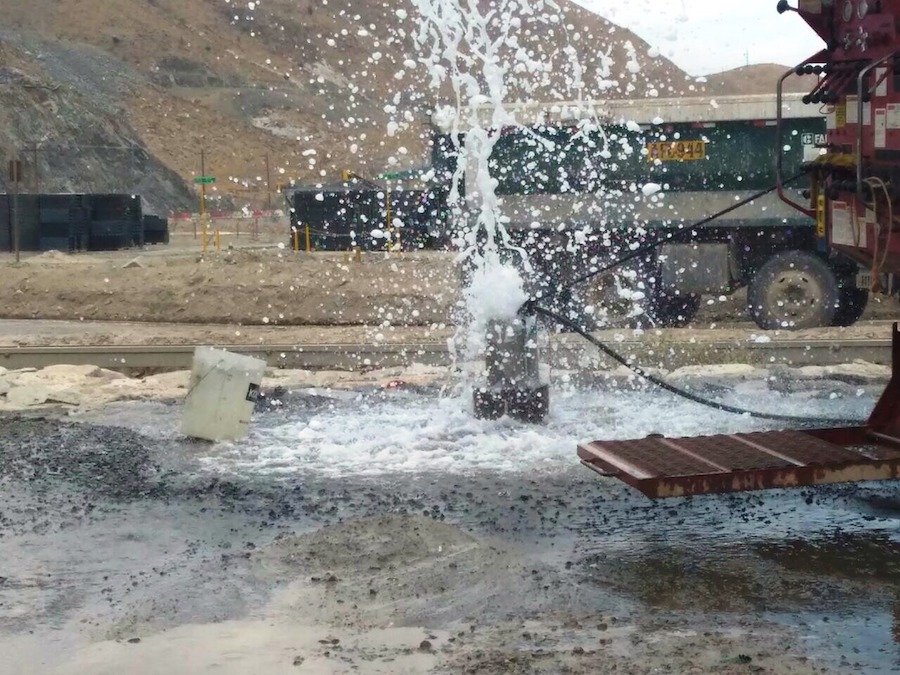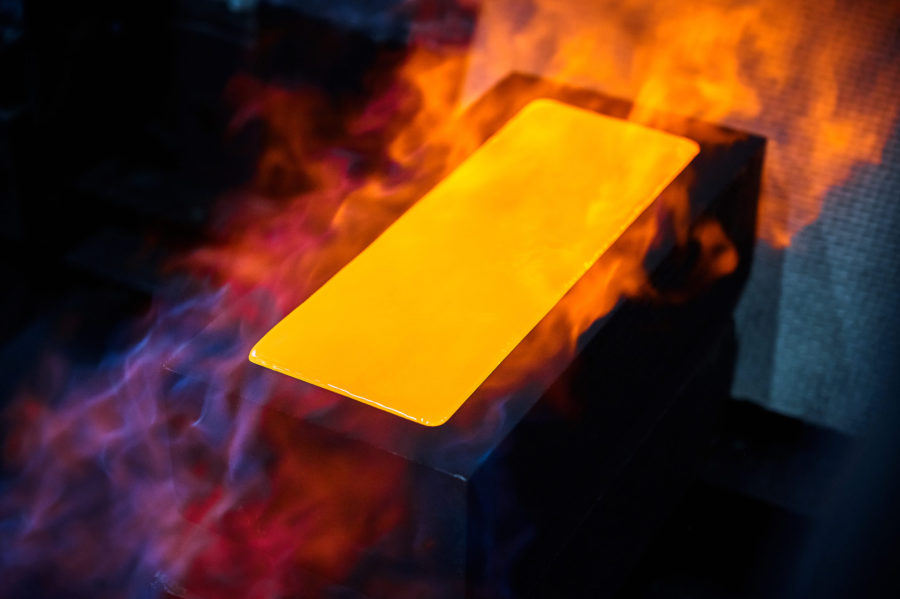Early hydrogeological studies critical to mining success
Hydrogeology – the branch of geology that studies the movement of groundwater – is often thought of in scientific or engineering terms, but in truth, it is as much a science as an art-form – where the art involves conceptual models of where water might, or might not, move, depending on a number of independent and hard-to-control variables.
The story of water movement
“Hydrogeology is kind of like telling a story. The more you get to know the site, the more you understand the groundwater story. Hydrogeology is mathematical, like engineering, but also has an element that will always be conceptual, because we can’t see it, said Rachael Peavler, a hydrogeologist working in Stantec’s Salt Lake City office.
Peavler will be speaking about groundwater and mining in her talk “Baseline Groundwater as a Foundation on which to Build a Successful Permitting Action,” at AEMA’s annual meeting and exposition, coming up December 4-8, 2017, in Reno, Nevada. Peavler is the first speaker of the December 6 session that runs from 8 am to 11:30 am.
Hydrogeology is a critical part of the exploration and mining process because companies need to understand what their impacts are on the environment so that they can obtain permits from regulatory agencies, both at the beginning and throughout the life of mine. A solid understanding of how water moves through a mine will also prevent problems from cropping up further into the operation, when for example expansions occur, and ultimately, when the mine is preparing for closure.
“To best understand what the impacts are going to be, you need to have a decently solid understanding of what your controls in groundwater flow and groundwater chemistry are going to be,” Peavler said, adding:
“We’re not designing a pipe to route water from point a to point b. There’s countless attributes to a groundwater flow system that are going to impact the quantity and quality.”
Early studies bear later fruit
This complexity of underground water movement is best determined early on in the life of a mine – ideally in the exploration stage. Unfortunately, in the drive to please shareholders and raise funds, many exploration companies are more focused on drilling for metals than for water. If they do collect data, it is often inadequate. But this can be short-sighted, and can come back later to haunt the company when they start applying for environmental permits, or further into the operation, when they wish to expand.
“The smart approach is to begin to collect groundwater data during mineral exploration,” said Peavler. “If an exploration hole is drilled and there’s no hydrogeologist working on the project, the opportunity to collect hydrogeology data is often missed. The hole is abandoned and the opportunity is gone.”
If adequate groundwater studies are completed at the beginning of mining, they become baseline data that can be the foundation for understanding groundwater flow as mining continues. “As your mine progresses, you’re going to continue to do focused hydrogeologic investigations. Maybe you have to make some modifications to your closure plan to address changes that weren’t predicted,” notes Peavler.
The understanding obtained from the baseline characterization prepares mine owners for those future investigations. For example, the general areas and timing of future mine water seepage are identified; future dewatering and water treatment rates are planned for; or areas of potential concern in pit wall stability are addressed. The understanding of each of these circumstances are refined throughout the mine life, but being prepared for them can make all the difference.
The costs of inadequate data
Failing to conduct groundwater characterization early can cost a mining company in permitting delays and costly add-ons like unexpected dewatering systems or treatment plants. This is especially true in the United States when federal money or lands are involved, which triggers environmental assessments based on the National Environmental Policy Act (NEPA).
“We’ve seen permitting in mines just fall apart and be delayed by years and years because of inadequate groundwater knowledge, and a lack of respect for the impacts that not knowing what lies below the surface can have,” said Stantec principal Ben Veach.
Veach explained that often consultants are hired to build a groundwater model that satisfies the regulator – then halfway through the environmental impact study, it’s apparent that the data collected was inadequate, or the mine location moved, throwing the study out of whack – which can delay the permitting process by years.
“Here is where it’s important to remember that a little bit of upfront planning can save a lot of pain and suffering – and costs – later on,” said Veach.
Peavler said that she often sees examples of inaccurate data that can throw off conceptual or numerical groundwater models. Data may be assumed to be high quality, but often it needs to be cleaned up by a hydrogeologist who is thinking about how the groundwater system operates. For example, measurements in dry wells are commonly reported as a true depth to water when in reality the instrument is reading the depth to the bottom of the well, rather than the groundwater level. This small error results in an overestimate of the groundwater levels, which could influence the hydrogeologist’s understanding of the conceptual site model, dewatering requirements, estimates of seepage, and predicted future environmental impacts of mine operation. Data errors seem small when taken one at a time, but they have the potential to have a compounding effect.
In a worst-case scenario, inaccurate groundwater data could mean the mine does not have enough water to carry out mineral processing. If a mine is relying on groundwater production for water supply and has not defined the long-term yield of the aquifer, inadequate water may limit or stop production. Understanding of the overall water management plan is important to define upfront.
Too much water is just as common as a mine not having enough. An open-pit mine that has been operating above the groundwater table wants to deepen the pit, but the pit is filled with water. This will require a dewatering operation, likely with the installation of costly wells, pumps, and conveyance. If the water is poor quality and disposal is required, construction of a treatment plant may be needed. Having water in the pit also affects the stability of the pit, which could mean additional engineering.
Dewatering operations can also affect groundwater systems outside the mine boundaries, which may lead to conflicts with other water users who depend on wells, streams, or springs not drying up.
Peavler said early water studies can assist in predicting, and mitigating against, scenarios like these.
“When you want to get water out of an open pit, there is a lot of upfront work, where you’re characterizing the hydrogeology. Which faults are acting as barriers to groundwater flow? Which faults are permeable and are transmitting groundwater from one point to another? All of this affects where you design your wells.”
Money well spent
When asked why some companies don’t budget for in-depth hydrogeological studies, Peavler used the analogy of collecting baseline groundwater data as being similar to putting a sewer line in a new house. If you are designing a house, the sewer line may not be as top-of-mind as the floor plan or the kind of cabinets you put in your kitchen, but its advancement is imperative to the success of your project, in the same way that collecting baseline groundwater data is a critical component of permitting and operating most mines. Collecting and interpreting groundwater data also generally represents a comparatively small portion of total mining costs.
Doing hydrogeological work early on not only serves to predict later water stewardship issues related to expansion or closure, it can also increase the value of a mining property, which is always of interest to exploration companies looking to attract investors and potential acquirers. Working with a skilled hydrogeologist throughout the entire mine-life can prevent miscalculations, ensure delay-free permitting, and assist in regulatory reporting during the various stages of operation.
“Having your ducks in a row with your data makes that process much easier,” said Peavler.
 Rachael Peavler will speak about groundwater studies and successful permitting at the AEMA annual meeting at 8 am on December 6 in Reno, Nevada.
Rachael Peavler will speak about groundwater studies and successful permitting at the AEMA annual meeting at 8 am on December 6 in Reno, Nevada.
More News
{{ commodity.name }}
{{ post.title }}
{{ post.date }}




Comments